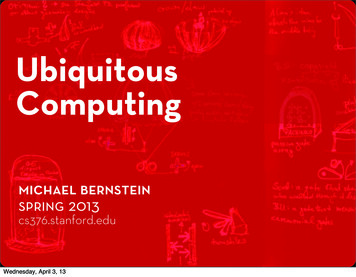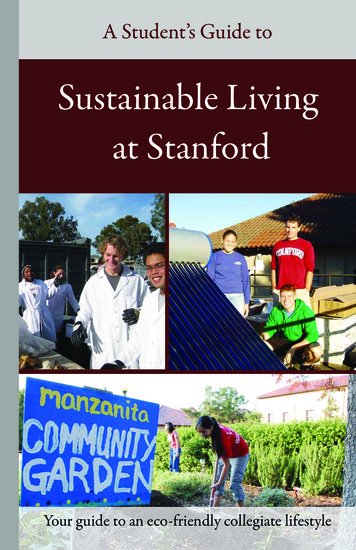
Transcription
UbiquitousComputingmichael bernsteinspring 2013cs376.stanford.eduWednesday, April 3, 13
Ubiquitous?Wednesday, April 3, 13
Ubiquitous?3Wednesday, April 3, 13
Ubicomp Vision‘A new way of thinking about computers inthe world, one that takes into account thenatural human environment’ wherecomputers will ‘vanish into the background’,weaving ‘themselves into the fabric ofeveryday life until they areindistinguishable from it.’Mark Weiser (late 80s/early 90s),quotes compiled by Daniel Fallman4Wednesday, April 3, 13
Beyond Weiser Ubiquitous computing is a set of visions fordistributing computation into theenvironment.5Wednesday, April 3, 13
Beyond Weiser Ubiquitous computing is a set of visions fordistributing computation into theenvironment. These visions require interactive systems tobecome reactive, context-aware, ambient,and embedded in everyday activities.5Wednesday, April 3, 13
Themes of ubicomp research Activity sensing and monitoringContext-aware computingInput techniquesCapture and access6Wednesday, April 3, 13
Tangible ComputingHiroshi Ishii, MIT Media Lab Directly-manipulable physical interfaces todata and computation ‘Pure’ form of ubicomp in that there is nocomputer to be seenPAPERSCHI 97 * 22-27 March 1997Tangible Bits: Towards Seamless Interfacesbetween People, Bits and AtomsHiroshi Ishii and Brygg UllmerMIT Media LaboratoryTangible Media Group20 Ames Street, Cambridge, MA 02139-4307 USA{ishii, ullmer}@media.mit.eduABSTRACTThis paper presents our vision of Human ComputerInteraction (HCI): "Tangible Bits." Tangible Bits allowsusers to "grasp & manipulate" bits in the center of users’attention by coupling the bits with everyday physicalobjectsand3,architecturalsurfaces. Tangible Bits alsoWednesday, April13BITS & ATOMSWe live between two realms:our physical environment andcyberspace. Despite our dualcitizenship, the absence ofseamless couplings between7
Urp: a luminous-tangible workbench for urban planning and design.Underkoffler, Ishii. CHI ’99.8Wednesday, April 3, 13
Urp: a luminous-tangible workbench for urban planning and design.Underkoffler, Ishii. CHI ’99.9Wednesday, April 3, 13
Ishii, Mazalek, Lee. Bottles as a minimal interface to access digitalinformation. CHI EA ’01.Wednesday, April 3, 1310
Ryokai, Marti, Ishii. I/O Brush: Drawing with Everyday Objects asInk. CHI ’04.Wednesday, April 3, 13
Transforming data intophysical form What Weiser calls one of the first calmtechnologies: Live Wire, a wire on a steppermotor, monitoring ethernet traffic[Jeremijenko ’95]12Wednesday, April 3, 13
Wearable ComputingSteve Mann, MIT Media Lab Access to computation on top of, under, orvia your clothing13Wednesday, April 3, 13
Wearable Computing Lilypad Arduino[Buechley et al., CHI ’08] And of course, Google Glass14Wednesday, April 3, 13
Hodges, et al. SenseCam: A retrospective memory aid.Ubicomp ’06.Wednesday, April 3, 1315
Context-aware computing Collect information about the user’senvironment, and use it to customize theircomputing experience Some types of context: location, socialsurroundings, activity level But beware overuse of the term ‘context’!Towards a Better Understanding of Context andContext-AwarenessAnind K. Dey and Gregory D. AbowdWednesday, April 3, 13Graphics, Visualization and Usability Center and College of Computing,16
Context-aware computing Detection of context is typically the hardestproblem Some successes: Localization using wifi access points[LaMarca et al., Pervasive ’05] Social networks using mobile phones[Eagle and Pentland, Pers. Ubiq. Comp. ’06] Google Now17Wednesday, April 3, 13
Input and interaction Effective control of ubiquitous computingsystems without the traditional inputchannels Gesture, on-body, on-wall, on-floor:on any surface available18Wednesday, April 3, 13
Harrison, Morris, Tan. Skinput: Appropriating the Body as anInput Surface. CHI ’10.Wednesday, April 3, 1319
Harrison, Benko, Wilson. Omnitouch: Wearable MultitouchInteraction Everywhere. UIST ’11.Wednesday, April 3, 1320
Activity recognition Sense the user’s physical state by using minimallyinvasive sensors For example, wearing five 2D accelerometers andpredicting tasks like walking, watching TV, reading,eating.Activity Recognition from User-AnnotatedAcceleration DataLing Bao and Stephen S. IntilleWednesday, April 3, 13Massachusetts Institute of Technology1 Cambridge Center, 4FLCambridge, MA 02142 USA21
Activity recognition Detecting the user’s state is powerful, butoften involves invasive sensors. So, monitor the environment rather than theuser: energy use, water use, activities of anaging population22Wednesday, April 3, 13
Patel et al. At the Flick of a Switch: Detecting and ClassifyingUnique Electrical Events on the Residential Power Line. Ubicomp ’07.23Wednesday, April 3, 13
Environmental Sensors Monitor secondary signals in theenvironment: biosensors!Nurturing Natural SensorsStacey Kuznetsov, William Odom, James Pierce, Eric PaulosHuman-Computer Interaction InstituteCarnegie Mellon UniversityPittsburgh, PA, USA{stace, wodom, jjpierce, paulos}@cs.cmu.eduABSTRACTSensing has played a significant role in the evolution ofubiquitous computing systems, enabling many of today’scompelling interactive and ubiquitous experiences. In thispaper, we argue for expanding the current landscape ofsensing to include living organisms such as plants andanimals, along with traditional tools and digital devices. Wepresent a field study of ten individuals who routinely workwith living organisms such as plants, fish, reptiles and bees,and relyon 3,theseWednesday,April13 organisms as well as analog instrumentsindividuals who use everyday biomarkers- commonbiological organisms that express information about anecosystem or its many parts. We present a field study of 10participants who routinely work with living organisms suchas plants, fish, reptiles or bees. While many people makeinferences about the environment (e.g., a cloudy skysuggests the possibility of rain), we expect our sample ofparticipants to be more attuned to environmental processesas their work explicitly engages with living systems.Specifically, we focus on participants’ use of digital24
What’s difficult aboutubiquitous computing research? Noisy inputs Sensor fusion Context is only a proxy for human intent[Dey, in Krumm 2009] Lack of standardization in interface patterns Privacy25Wednesday, April 3, 13
What are open opportunities inubiquitous computing research? The hardware is increasingly easy to find andto programArduino Uno26Wednesday, April 3, 13
What are open opportunities inubiquitous computing research? New I/O opportunities are coming out everyyear — from industry and from HCIresearchersWednesday, April 3, 13
Next ubicomp topics Pervasive Infrastructure-mediated sensing and the meaning oftechnology as infrastructure Interaction Muscle-computer interfaces and 3D printing Global Citizenship Avaaj Otalo: cell phone-based information networks Design tools d.tools: prototyping ubiquitous computingapplications28Wednesday, April 3, 13
Credits:Flickr user GARNETWednesday, April 3, 13
Apr 03, 2013 · work to investigate performance of recognition algorithms with multiple, wire-free accelerometers on 20 activities using datasets annotated by the subjects themselves. 1 Introduction One of the key difficulties in creating useful and robust ubiquitous, context-aware computer applications is developing the










